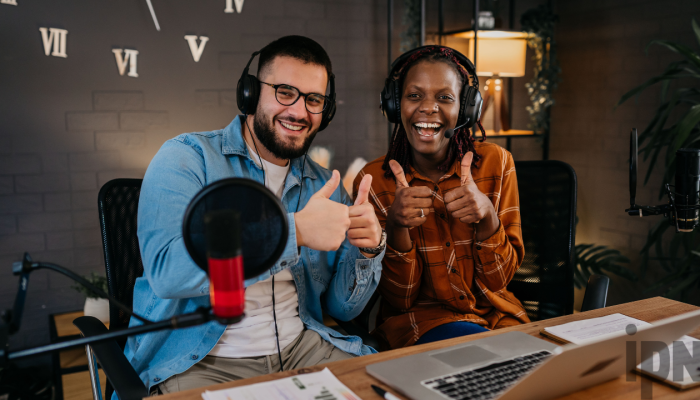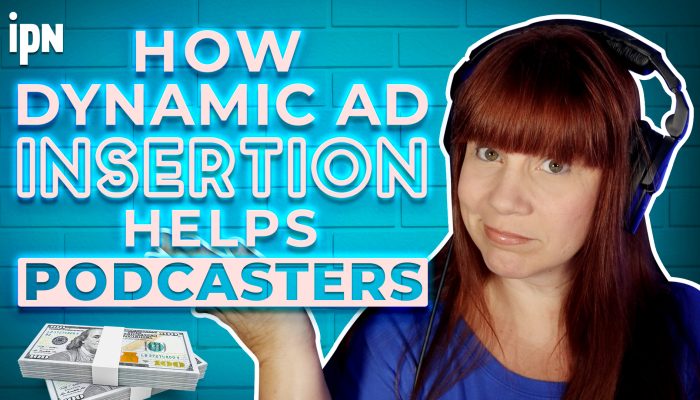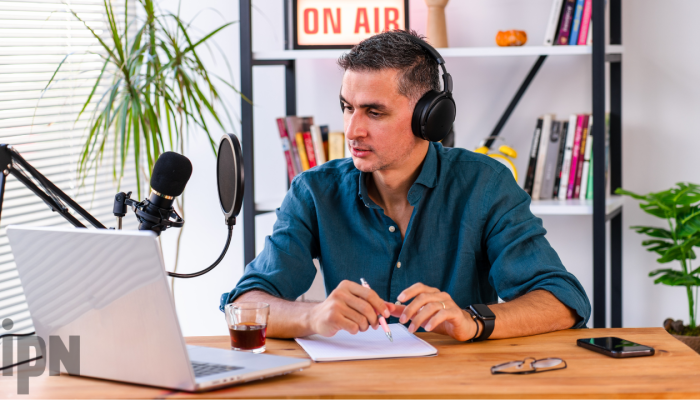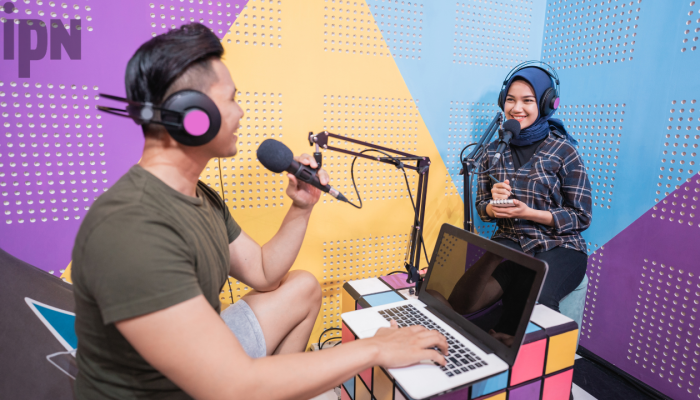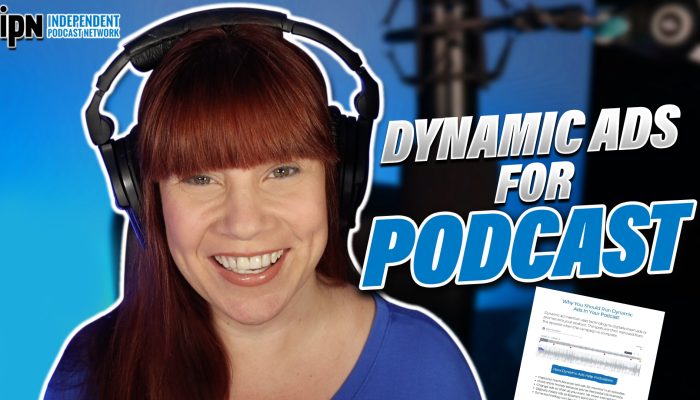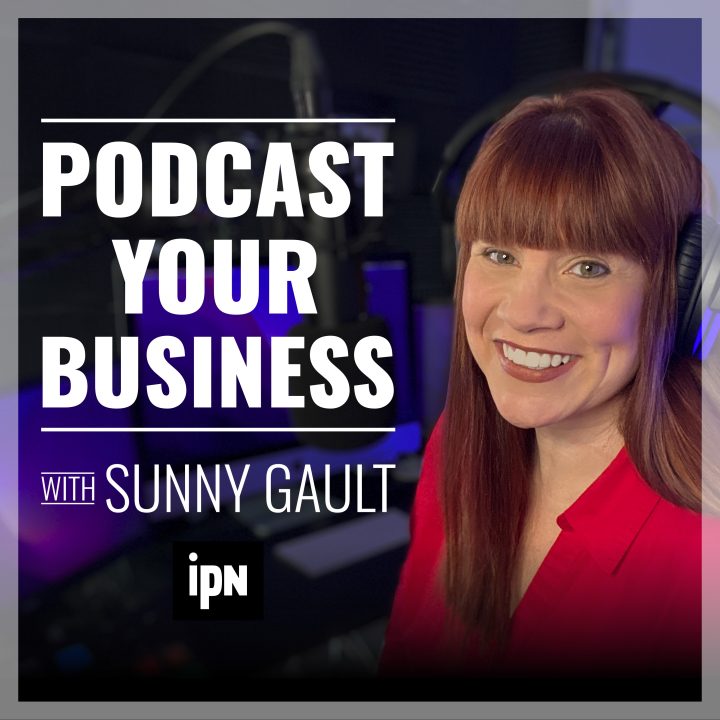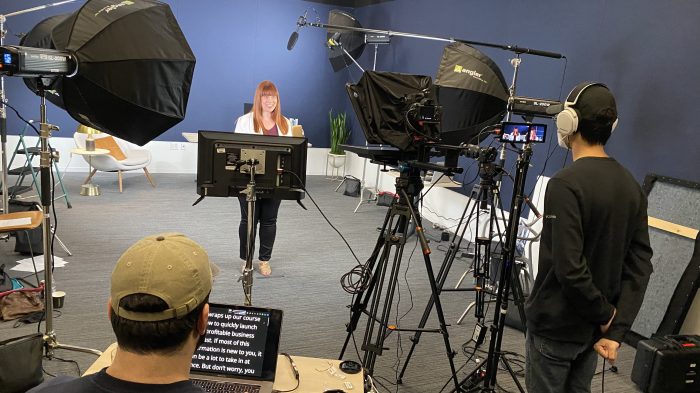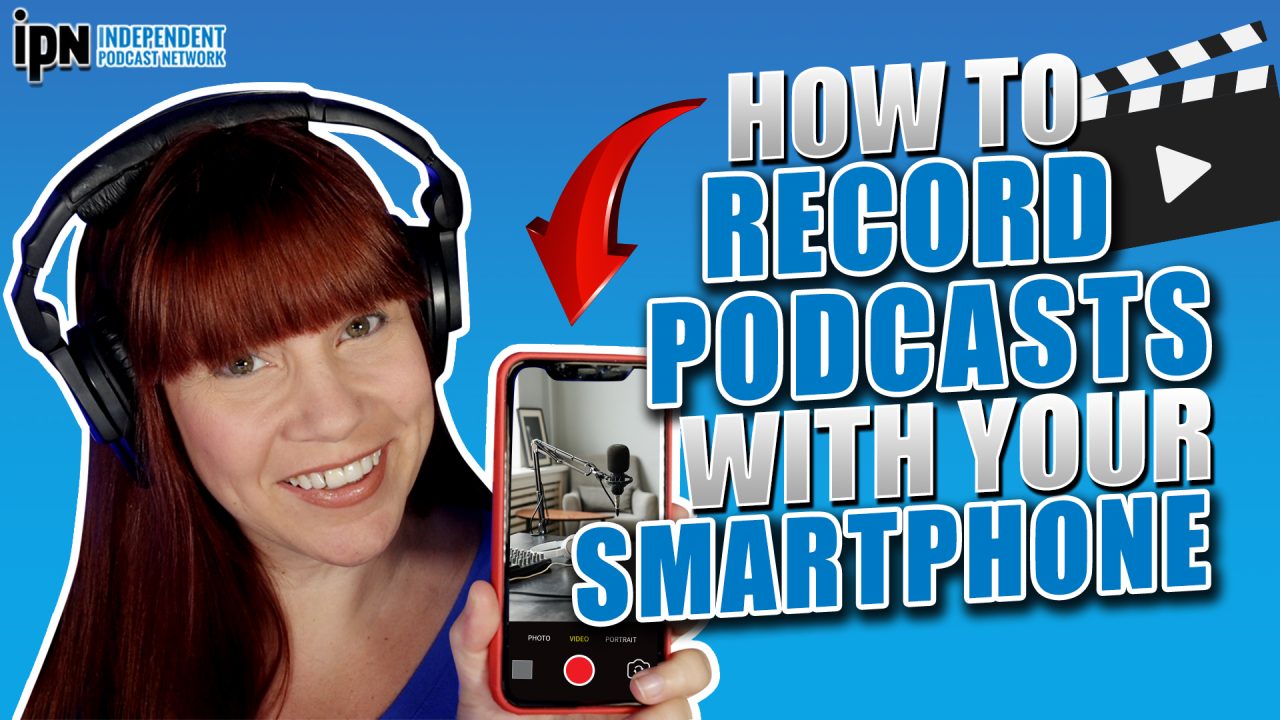
produce great audio on-the-go!
You don’t need a bunch of fancy podcasting equipment to have a quality podcast. In fact, technology has improved so much that you can now record your entire podcast through your smartphone. But should you? What are some of the pros and cons? And what are some things to help you get the best audio possible? Today we’re talking about how to record podcasts with your smartphone!
Here’s what we’re talking about today…
- Should you record your podcast with your smartphone?
- What equipment do you need?
- Tips for getting great audio on-the-go
- Testing and reviewing podcast all-in-one apps
Want our top podcast equipment picks?
Want to get my top recommendations for podcast equipment? Download our equipment guide to fit every budget.

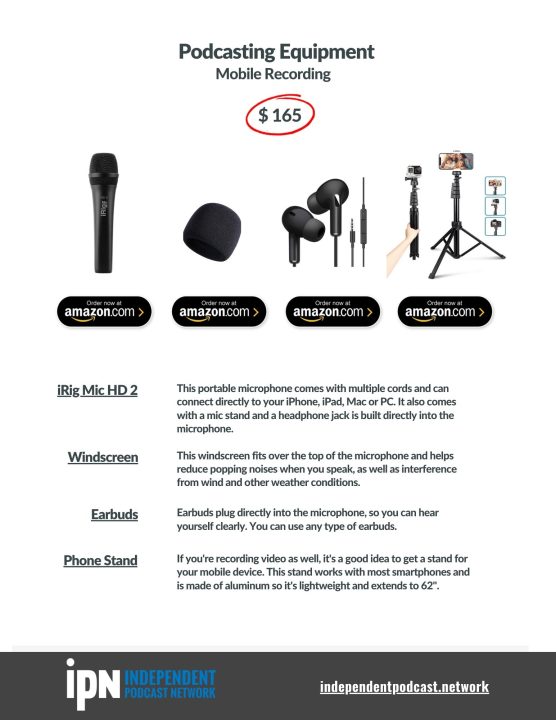
Episode Transcript
0:01
You don’t need a bunch of fancy podcasting equipment to have a quality podcast. In fact, technology has improved so much, you can now record your entire podcast through your smartphone. But should you? What are some of the pros and cons? And what are some things to keep in mind to help you get the best audio possible? Today we’re talking about how to record podcasts with your smartphone. Take it away radio man. Podcast Your Business.
0:34
Hello, and welcome to Podcast Your Business. I’m Sunny Gault. I’m a podcast coach and mentor and I have been podcasting for 17 years. I’m also the founder and CEO of a company called Independent Podcast Network. You can find us at https://independentpodcast.network. And please check out the site because we have amazing resources, new courses are being launched new handouts, new blog posts, podcast episodes like this one. And everything is absolutely free for you. Today, I am here to help you create amazing podcast specifically for those of you who are podcasting for your business. And we do this by mastering the five P’s of podcasting. That’s right, the five P’s. This is something that I created, and one of the first podcasting courses I launched. And it’s a free course it’s available on the website, but we go through the five P’s because I believe if you master these, then you’re going to have a successful podcast. And those P’s are prep, plan, produce, promote, and profit. So when we talk about prepping, we’re talking about should you even start a podcast? Have you done your research? What’s your motive behind all of this? Because this is kind of, you know, this is another project, some people even think it’s a second job, depending on what you make of it. Are you ready to handle that plan, we talk about the look and feel for your show, we really dive into the format, and make sure that what you want to do really aligns with what you’re trying to accomplish, produce, how do you create the content? Right? That’s the recording process and editing, promote? How do you tell everyone about it? So we talk about different ways to promote your show websites, social media, you know, cross promotion with other shows. And then finally, profit? How do we make money with this? You don’t necessarily have to have advertisers on your show. That’s something that we specialize in with Independent Podcast Network. So if you guys want to work with us, if you’re interested in finding advertisers, we can help you with that. But it’s also about how do you change the format of your show to really allow for advertising? And how does this work its way back into your business. Because if you’re podcasting for your business, it has to tie in, it has to bring you more clients, there has to be a reason that you’re doing this right. So Mr. Radio Man, which of those five P’s are we talking about today? Produce.
3:03
That’s right, we’re talking about producing your podcast. And if there’s one thing that I’ve learned over the last 17 years of doing podcasts, is that everybody has their own unique way of producing their episodes. Technically, you can record your podcast, edit it, upload and publish all through a podcasting app, and be done with it. We’re going to explore that a little bit today. But the question you need to ask yourself is, is that process going to help you and your podcast and help you ultimately achieve your podcasting goals? That’s what we’re gonna find out. We’re gonna dive right into it. So here are some of the things that we’re going to talk about in today’s episode, we’re gonna really dive into the question of should you record your podcast with your smartphone? Is that even a good idea? Just because you can do something doesn’t mean you should do something. Right. So I’ve got some questions, some things for you to consider before you determine if you want to go down that path. Next, if you are going to do a little bit of that, even if it’s not always, what kind of equipment are you going to need, because there is some specialized equipment that I do recommend. Next. And this is really important. We’re going to talk about tips for getting great audio on the go. Because and by the way, today’s episode is really going to focus on audio podcast. A lot of times when I do these episodes, I tried to bring in tips for video and audio. It was too hard to do for this episode. So we’re just focusing on the audio podcast, and how do you really get amazing audio on the go, because when you just have audio, it’s got to be amazing. A lot of times if you have a video podcast, the video can kind of compensate for the audio, but I can’t do that with just an audio podcast. So what are my best tips for getting that amazing audio on the go? And then finally, this is going to be kind of fun. I tested and reviewed a couple of podcast apps and I’m gonna call these all in one apps. I’m not sure if there’s an official term, but these are apps and they’re both with podcast hosting providers who are now allowing you to record your podcast, do a little bit of editing and adding, you know, some stuff here and there. And then you can upload it directly to that podcast host provider. And this can all be done through your smartphone. So I tested a couple out, I’m going to share my thoughts with you guys. We’ll get started with this after this quick break.
5:26
Should you record your podcast through your smartphone? This is the big question I think you need to ask yourself, before really going down this path, like I said earlier, just because you can do something doesn’t mean you should. I mean, it’s nice that this technology is available. But easier, you know, doesn’t necessarily mean better. But there may be times that you want to use this, I just don’t want you guys to sacrifice quality over convenience. So let me give you guys a little bit of background here. When anchor came out, if you guys have heard of Anchor, it’s no longer called Anchor, we’ll dive into that a little bit more was Anchor.fm, Spotify bought it. But when Anchor first came out, this was going to be the go to tool that people could use to start a podcast through their smartphone, you don’t have to have all this other equipment. And let me tell you, they really kind of messed up the podcasting space there for a while, okay, because people were getting on and quote unquote, creating podcasts. But it was the worst quality. Maybe they did one episode, maybe they did two and they called it a podcast. And I feel like it really confused the market. Which isn’t great, right? Because you don’t want listeners to have to have like a sea full of crap in order to dig through in order to find good content. So having a bunch of shows, quote, unquote, that had one or two episodes that people were just messing around with really didn’t help. But it kind of got everybody thinking about how can we improve this? And how can we make this better? So I tell you that story, because I don’t want you to sacrifice quality. Just because something is more convenient. Just because you can do this doesn’t mean you should. But I do believe there are times where recording through your smartphone does make sense. So let’s go over some of these because this could apply to you. First of all, if you’re just testing out this whole podcasting thing, right, someone said, oh, you should start a podcast, I don’t recommend that you get too far, you know, deep in the weeds, so to speak, in, you know, buying equipment and setting everything up and hiring a podcast coach and doing all that kind of stuff, I think you should kind of just test it out. So if you are in that camp, and you’re like, that might be kind of fun, maybe not, maybe test out one of these podcasting apps that I’m going to talk about a little later on, and kind of get your feet wet, and see if it’s something that could be a good fit for you. So that could be kind of an interesting thing to try. Also, you can record with your smartphone, if you’re traveling and you don’t have your laptop, or something happens to your laptop. And I’ve been in that kind of situation before, right. The other thing is, you might be in situations where something happens, it’s a very unique moment, a special moment, you weren’t prepared because you didn’t know what’s gonna happen. Like, I don’t know, maybe you’re having a baby or your wife’s having a baby or something amazing happens and you want to capture it. But you weren’t prepared because it’s just it’s life, right? This could be a great way to capture something to have in your podcast at a later time. Or maybe it is its own episode. But those special moments that you want to capture, we all have our smartphone on us, right? So it’s helpful to have these tips and tricks. It’s like in your in your little podcasting tool bag, just in case you need it. So I mentioned your equipment breaking, you know, you need some sort of backup that literally has happened to me in the past. And I needed that. Also if you ever plan to attend a live event. So in the past, I have gone to different podcasting events. And it’s not practical for me to carry around my laptop, right? I need some sort of mobile way to interview people talk to people, I’ve live on the expo floor, or maybe I’m recording stuff for later that I want to use in different ways. That’s another great reason to record with your smartphone. But I don’t recommend that you just say oh, that’s just going to be easier. So I’m just going to do it even though I’m at home and I could totally have a decent podcast setup. Please don’t do that. That’s not what I’m advocating for today. But I think this is a tool that you could use in the future and you just never know when you’re going to need this.
9:42
Okay, so if you are going to record with your smartphone, there is some equipment that you need. First of all, guess what, you need a smartphone. And I think we’re all at that stage where we all have decent enough smartphones if you’re listening to this podcast, you’re probably tech savvy, right you getting updates every few years, at least three to four years on your smartphone. So I’m not too worried about that. So you have your smartphone. You also need an external microphone. Can you just record by speaking into the microphone at the bottom of the phone, right? You’ve seen someone hold their phone and speak into the bottom of it. Because your voice does sound better when you do that. Can you do that? Yes, you can. The problem is, even with an iPhone, now I don’t have a real fancy iPhone, I have an iPhone 11. So I wasn’t willing to upgrade to the 14, 15, 10,000 whatever they’re on right now. But even with my iPhone 11 I can speak into it. My voice sounds great. But I can hear all the background noise too. So that is the problem with not having an external microphone. There is a microphone that plugs in and this only works with iPhone, iPad, Macs and PCs. Okay, so Android users, I’m so sorry. But the phone or sorry, the the microphone that I recommend that plugs right in to the lightning port on your iPhone is called IK Multimedia. It’s the iRig Mic HD2, I know that’s a really long word. But if you type that into Amazon, it’ll pop right up. Okay, there’s an HD one, get the HD2 because the HD2 has a headphone jack. And that’s going to be really important because you want to hear how you sound. If not, you are probably going to sound too loud, because you’re gonna think you have to scream into it. And then your voice is going to sound over modulated. I literally did this because I have the HD one version, I don’t have the HD to I need to upgrade. And it does not have the headphone jack and I went out to this. It was this expo and I thought my levels were okay. But I couldn’t hear. And I was actually streaming live. And if it weren’t for the audience telling me to quit screaming into the microphone, or lower your levels or whatever they said, I would have had no idea. So please get the HD2, it’s got the headphone jack, it also comes with all the cables, you’re going to need to connect to your phone. So that is the lightning cable that connects to your iPhone. And they give you a secondary cord to so that you can connect your phone to your computer, if you want to transfer files that way. And this is cute, it comes with the little table tripod. So you can just kind of set your phone in there. And that is important that kind of leads me to the second bullet point is having some sort of stand so your phone can be hands-free. Now that is more important if you are not in a live event type situation. Because if you’re at a live event, you’re probably not gonna have a table right in front of you, you are going to be walking and talking. But if you happen to, you know, be recording on the go, right, so if your laptop dies, and whatever, you’re not going to want to hold your phone. So having some sort of system that sets it up can work. If you have a table in front of you, a lot of times I just use the table and just set it down, just try not to bump it because you will hear everything. But what’s nice about the iRig Mic HD2 is that it does have its own table tripod. So you can set it up and not have to buy anything else.
13:21
Okay, and then you’re also going to need some sort of audio recording app. Now, if you have an iPhone, you have something called Voice Memo on your phone, I believe that comes standard that’s already built into your phone, you don’t have to download it. That is an option. So I’m going to talk about the voice memo and a few other options that you have. Really just use whatever feels good for you. I’m just giving you guys options today, because you do have to have a way of recording your voice. And a lot of this is just based on personal preference. So if you don’t like looking for apps and downloading other stuff, try the Voice Memo out first, I do recommend that you change some of the settings on that. And you can do that in settings, you would go to iPhone settings, go to voice memo, audio quality, and then change the quality from compressed, which I believe is the default to lossless this is going to make the file a little bit bigger. But it also means it’s not going to compress it and it’s going to sound better because you want the highest quality version of audio that you possibly can. So if you’re going to use voice memo, it’s really easy to use writes got a big old red record button, you hit it, you hit it again to stop. And then you can export your file. And you can export it in a number of different places. So you could send it through text message, you can upload it to Dropbox or Google Drive or email, whatever you want. So that’s a great thing to consider. A couple other apps that I think are worth checking out if voice memo is not your thing. If you want something that’s kind of similar, you could also use an app called Voice Recorder light. And it has a lot of the same functionality as Voice Memo. So it’s something to check out, there’s a lite version, there’s a paid version, if you do the light, there’s going to be some ads. So just consider that. The other one that I thought really does take it up a notch is something called Voice Record Pro. And you I believe there’s a free version. But then if you upgrade, I don’t know how much it is, it’s like a few bucks or something like that. But if you upgrade, then you have a lot more functionality. But with this, it actually has the VU meters, you know, the little meters that go back and forth. So you can see if your audio is peaking or not, I thought that was really cool. But even prior to recording, you can select a lot of audio settings, which is great. So you could change it, you know, each time you recorded, you could change the settings. And this is a feature that isn’t available, I found that a lot of these audio recording apps, but Voice Record Pro does have it. So maybe check those three out and see which one you like the best. Now another version, or another option for you guys would be to use a remote recording platform. I’ve talked about this and other episodes, remote recording platforms, you can use that on your PC or on your Mac, okay, they’re usually browser-based. But a lot of these platforms are also coming out with apps. So you can also use their platform and invite even multiple guests to join you in a recording. Now, this is still kind of, you know, not not not all recording platforms have this, I believe riverside.fm already has it, that’s the only one that I could see in my brief search online. But keep in mind, if you go that route, there is going to be a monthly fee, because you’re going to have to have an account with them. And I believe all of them, you know are going to require at least if you use their app, they’re going to require that you pay something. So if you’re looking for the free versions, really the Voice Memo, Voice Recorder Light, you got to deal with some ads, Voice Record Pro, you’re gonna have to deal with some ads there as well. Those are the ones that you can use for free. And one more option I want to tell you about. And we’re going to do some testing with this in just a little bit is what I’m calling the podcast app, the all in one podcast app. So there are two that I have found that are promoted quite a bit online. One is from Podbean. And another one is from Well, it used to be called Anchor. But they’ve changed their name. They’re now part of Spotify. So they call it Spotify for Podcasters. But it used to be called Anchor. And both of these apps allow you to not only record your show, but then you can do some editing, you can add some stuff, and then you can upload it directly to that podcast host provider and it can be available through your RSS feed. That sounds kind of incredible, right. But remember what I said earlier, just because you can doesn’t mean you should. So we’re going to do in just a bit is a little demo, and I’m gonna give you a breakdown, because actually tested out both of these apps to see if they were worthwhile. So stay tuned for that.
18:27
Next we’re going to talk about my favorite tips for getting great audio on-the-go. Because that’s really what we have to focus on here. We don’t want to sacrifice the quality of our show. Yes, if we’re trying to get something you know, people kind of understand if you’re at a live event or whatever, there’s going to be noise in the background. And they’ll forgive that, but not on a regular basis. So how do we get amazing audio first, now this is sometimes hard to do. Try to record in a quiet place. The exception to the rule would be what I just said if you are live or if you are recording from a convention floor and expo floor that is not going to happen. You know what I like to do I like to tell people what’s going on so if there is a crazy noise or something going on in the background someone’s jackhammering or whatever, just say, hey, we picked this spot. We thought it was gonna be really quiet. And there’s a jackhammer here. I don’t know what to tell you. So ignore the jackhammer if you can, but try to record in a quiet place. Next and we talked about this a little bit earlier, mount your phone to keep it secure. Why do we want it to be secure? Because we don’t want a lot of external things hitting the phone or making unnecessary noise. Okay, this goes back to just keeping everything as quiet as possible. Next, think about your microphone placement. This might be a little bit different if you’re recording on the go because you’re not in your regular setup. You know when I’m in my regular studio, I know exactly where to position my mic. You know, it’s at a diagonal and there’s like, you know, a couple fingers distance between my mouth and the mic. I know how to do all of that. But you might have to do some testing to determine what’s going to work for your remote setup. But you need to be very mindful of where your microphone is, obviously, the closer you can get it to your mouth, the better without any huge popping noises and things like that. But you don’t want to pick up all the other noise in the room, right, you really just want to focus on whatever it is that you’re saying. And then finally, watch your audio levels. So this is why I like that one app that I was telling you guys about, I think it was voice record pro because it has the VU meter. So you can visually see, you know if your levels are peaking, but you need to have a way to test that this also goes into its ties into having the headphone jack and being able to listen, that’s good, but you really should be watching levels. If you’re peeking into the red, that’s not good. It’s gonna sound over modulated, you could crack you know, it could sound very distorted. So watch your levels. And again, do some tests in advance to see what it sounds like.
21:09
Okay, now for the fun part. Are you guys ready? I did some testing of these podcasts all in one apps. And I want to share my brief review with you guys. So I thought the best way to do this would be to actually record inside the app. And then you can actually hear what my external microphone, the one I’ve been bragging about all day, the iRig Mic, you can hear what that sounds like. And I’ll kind of go through and explain what I’m looking at. So we are now in the pod bean app. And we’re using our external microphone, you do need to have an account with Podbean in order to use this app this recording feature, but it can be a free account, because you’re probably not going to use this feature all that often. So you don’t need a lot of space. So you can keep with the free account. And what’s nice about this, it’s fairly easy to use, right, there’s a big recording button. So you hit the recording button, you do have some options to do some sound effects that they have built in. You also can add music. But if you want to import your own music, then you do have to have a paid account for that it’ll prompt you if you don’t already have one. But this is pretty easy to use, you know, I can see the waveforms, I can see how long I’ve been recording for. And when I’m ready, all I have to do is hit the stop button. So I’ve hit the stop button. And now I can do some basic editing. But it’s pretty much just, you know, trimming the ends, right. So I can change the start point. And the end point. If you are looking for something where you can edit out certain words, write are whole statements, forget about it. That’s not what these apps are designed to do. But you can do basic in and out, save. And then it’s asking me to title it. So it’ll save to a section that’s part of the app called my recordings. Then from there, you can add an intro or an outro if you want, but I believe you can only select from their music, I don’t think you’ve got the option to upload your own. So I’m gonna go ahead and export this. So you guys can hear what this is gonna sound like, you’ve got all the different options that you would if you recorded anything on your phone, right. So text message, any kind of app that’s on your phone, if you wanted to email it, you could do that, too. It gives you all of those options.
23:22
Now we are inside the Spotify for Podcasters app previously known as Anchor. And one thing that I can tell you even before I started recording is that this has a section for voice messages. And this is one of the things I really like about this app. So you know, we’re always trying to get audience feedback and for people to participate in our shows. And Spotify will actually give you a link that you can send to your listeners, and they can leave voice messages. And then you can easily incorporate those voice messages into your episodes. So I thought that that was really cool. And that is accessible through this podcast app as well. So then you go in and then you start recording like I’m recording. Now, they do have a section where you can add a flag, which this is interesting. So if you like make a mistake or something like that, you click this little button. And then apparently later on if you want to do some editing, it will remind you of those flags. However, I have to tell you, I could not find the flags no matter what I tried to do. They do have an editing section where you can again trim the ins and the outs but that’s pretty much it. So I love the idea, but it’s not really obvious to someone even like me that’s used to podcasting how you can implement that feature. Now I’m gonna go ahead and hit stop. So now it’s processing everything and there is a section where it says add background music. So at that point, I could add my music afterward, but not while I’m recording. There’s also a button for trim so I could go in there and this is interesting, then you have to flip your phone to the side. I don’t know if that’s a big deal for you guys, but I could pick my start and my endpoints. Once you save your clip, something interesting that this app allows you to do is basically record your episode in chunks, okay in different sections. So after you save it, you could go ahead and record another section of the episode if you wanted to, and then later compile them all together. So I thought that was interesting. When it’s time to export your file, your only option with the Spotify app slash anchor app is to publish it to Spotify. So you’re already logged into your account, you can only have one RSS feed or one podcast that’s part of your account. So you go through and you have to publish it, you’ve got to give it a title description, everything you would normally do. There is no other option at least that I can see to export just the file that makes this app kind of a no no for me unless Anchor slash Spotify is your podcast host provider and you just want to get something up really quickly. For most of us, that’s probably not going to be the case. So I doubt I personally would use this app for that very reason. But because this is a learning episode, and I’m trying to teach you guys what this sounds like, I’m gonna go ahead and publish this, just so I can download it, because once you publish it, then you can download the episode. And then I’ll have it so you guys could hear the quality. So that’s how I actually got that section into today’s episode. But there’s no easy way to export. And that is my official testing and review for these two podcast apps, both for pod Bean, and for anchor slash Spotify for podcasters. Now it’s possible by the time you hear this, there could be other companies, other businesses out there, this industry is constantly changing, and I know the technology is just going to get better and better. But that is where we stand for today. So I’ve got some free stuff for you guys. Stay tuned, I’m gonna tell you more about it right after this break.
26:58
Thanks for checking out today’s show, guys, I hope the tips and information they gave you is helpful. So that next time when you’re thinking about should I record with my smartphone, I hope you refer back to this episode and some of the tips and tricks that I taught you. We’ve been talking today a lot about equipment and using various types of equipment in different scenarios. I do have a free handout called buying the right equipment for your podcast. And there is a section in that which talks about recording on the go and recording with your smartphone. So if you’re interested in some of the items that I talked about today, specifically, that microphone that I tested today, the one that I recommend, there are affiliate links for Amazon in this document, and it’ll take you right to the page. Obviously all that money goes back into us providing free content for you guys. So I very much appreciate it. But most importantly, I want to make sure that you get the right equipment, so that you feel comfortable doing your shows on the go. If you haven’t checked out our website yet, please do so at https://independentpodcast.network. A ton of free resources there. I just launched a brand new course it’s a free course all about dynamic ad insertion and is it right for your podcast? And if you think it might be how do you implement this and how do you start making money with your show? So that is free on the website. Be sure to check it out. And we have a lot of other great stuff too, including weekly blog posts that come out. New handouts, new information all the time https://independentpodcast.network. Until next week, remember, podcasts are awesome!
